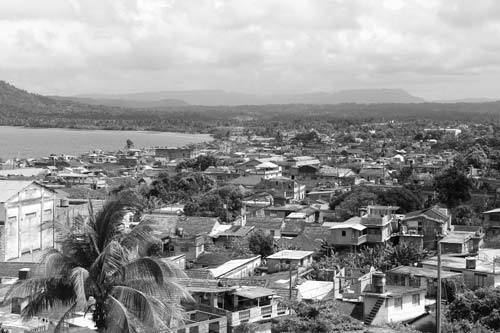
RESERVA DE LA BIOSFERA CUCHILLAS DE TOA
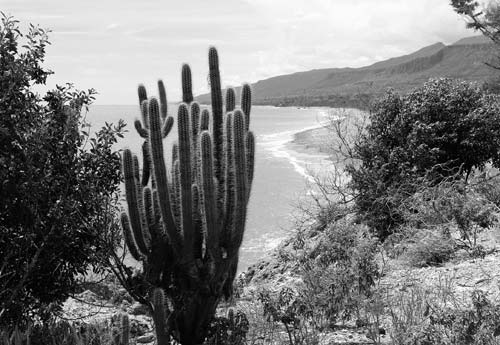
Guantánamo. The name reverberates around the world. Everyone knows it as a U.S. naval base and a humiliating thorn in the side of Castro’s Cuba. In fact, Guantánamo is also both a city and province, which tapers eastward to Punta Maisí, the easternmost point of the island. The province is almost wholly mountainous. Except for a great scalloped bowl surrounding the town of Guantánamo, the uplands push up against a barren coastal plain.
The wild eastern shore and secluded mountains offer fantastic opportunities for hiking. Uniquely, traces of indigenous culture linger around Baracoa, Cuba’s oldest city, near where a ball court similar to those of the Mayan culture has been discovered. Baracoans claim that Columbus first set foot in Cuba here and left a wooden cross (now on view in the town’s cathedral) as a memento. Whatever the truth, it’s undisputed that the Spanish conquistadores who came on Columbus’s heels established the first town in Cuba at Baracoa. The town retains an aged colonial feel in a setting that any other city would die for.
Today the mountain region is protected within a system of reserves slowly being developed for ecotourism. These mountains harbor rare plant and bird species and the Polymita pictas (snails that haul fabulously colored shells on their backs). The northeast coast and north-facing mountains are the rainiest region in Cuba. By contrast, valleys along the southern coast are pockets of aridity, and cacti grow in the lee of Cuba’s wettest slopes.
A single badly deteriorated road hugs the north coast, linking Holguín and Baracoa (public transport along this route is infrequent). For scenery, you should definitely plan on the Guantánamo city to Baracoa route via La Farola, a wheezing mountain switchback that has some nerve-wracking bends and slingshots you over the Sierra Cristal. The other option is the remote, arid, and dramatically scenic eastern shore route via La Maquina. Trains connect Guantánamo city to Santiago de Cuba and Havana. Víazul also offers daily bus service from Santiago de Cuba to Guantánamo and Baracoa.
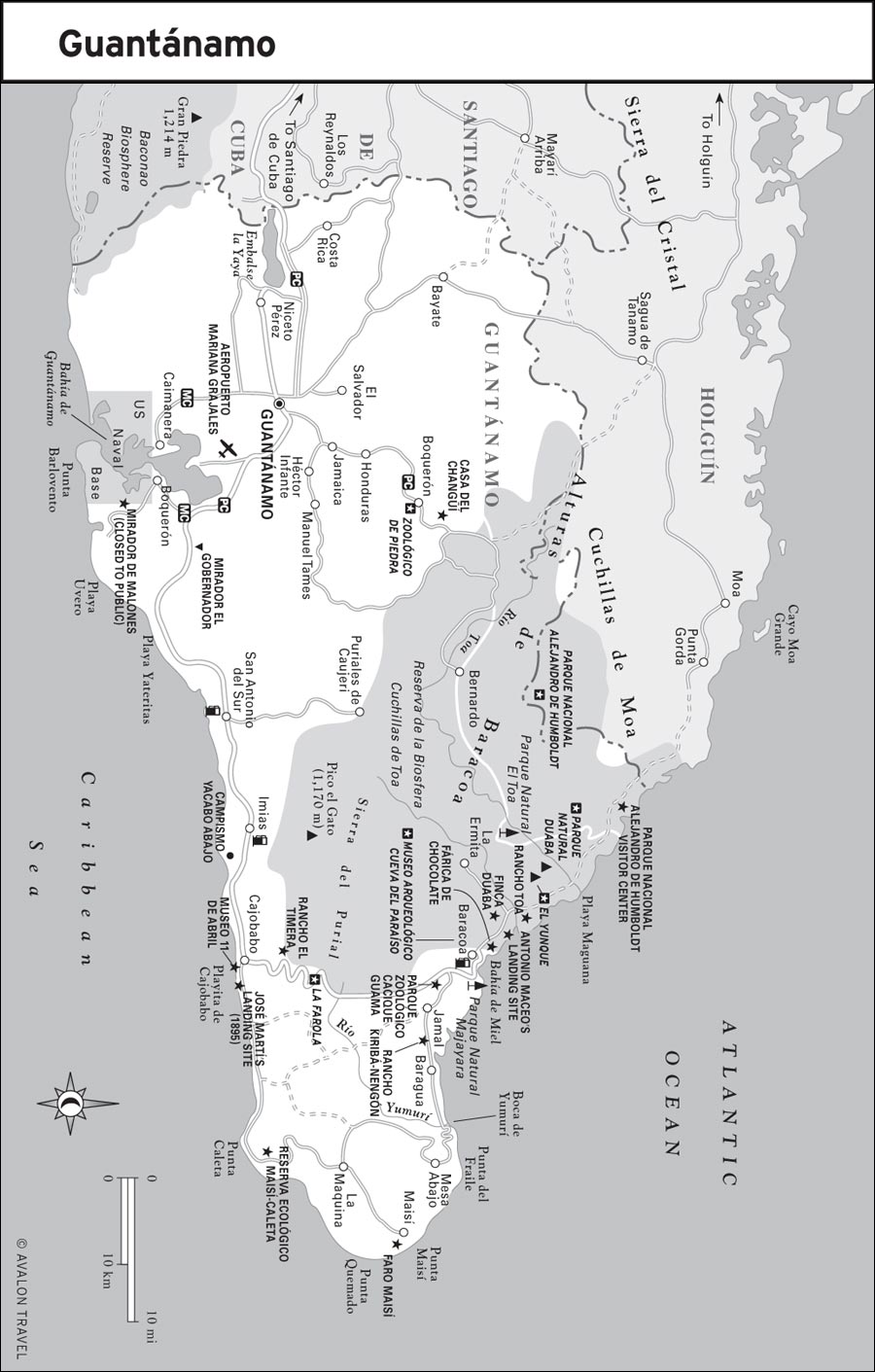
The town of Guantánamo is more a place to overnight in passing. However, it has a lovely colonial plaza, and the cultural and music scene is striking, with more traditional Afro-Cuban cultural centers than you can shake a stick at.
The hinterlands of Guantánamo township boast two sites of unique appeal. First, the U.S. naval base holds a fascination that many travelers can’t resist. While the chances of visiting the base are actually less than you winning the lottery, you can get to see it from the most unlikely place imaginable: a Cuban military lookout at Caimanera. You’ll need to set things up in advance, but the Cubans make it easy by offering prearranged tours handled through the Gaviota tour agency. Not to be missed is the Zoológico de Piedra. Within a one-hour drive of the city, this “stone zoo” features more than 200 life-size animals hewn from rock.
History buffs on the trail of José Martí should make a pilgrimage to Cajobabo, with its Museo Municipal 11 de Abril honoring Martí’s landing at nearby Playitas, where a clamber over beach boulders reveals a marble monument at the exact spot where the nationalist hero stepped ashore. You can take in both the stone zoo and Cajobabo in a drive between Guantánamo and Baracoa.
Baracoa deserves two days minimum. One day is more than sufficient for sightseeing, with the highlights being the Catedral Nuestra Señora de la Asunción and the not-to-miss Museo Arqueológico Cueva del Paraíso. The second day you’ll want to hike to the top of El Yunque, perhaps combined with horseback riding nearby or kayaking in search of manatees in Parque Nacional Alejandro de Humboldt.
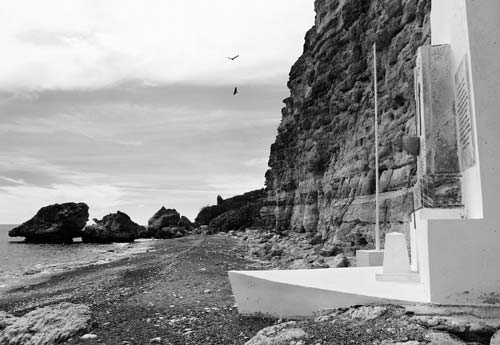
marble monument to José Martí inset into the cliff face, Playitas
Guantánamo, 82 kilometers east of Santiago de Cuba, is a large city (pop. 180,000) at the head of a deep bay of the same name and some 25 kilometers inland of the U.S. naval base, which lies at the mouth of the bay. The attractive colonial heart of the otherwise ungainly city has been spruced up; it’s an architecturally fascinating city, with many fine examples of art nouveau and art deco. Much of the population is descended from Haitian and English-speaking Caribbean immigrants who arrived in the 1920s to work in the sugar fields. The connections are strong.
Given the proximity of the U.S. naval base, there’s a strong Cuban military presence (when serious friction occurs between Cuba and the United States, the city gears up for a worst-case scenario). U.S. Marines first arrived here in June 1898 during the Spanish-Cuban-American War, following which the town developed a near-total economic dependency on the base, which employed hundreds of Cuban workers. Prostitution was also a major industry.
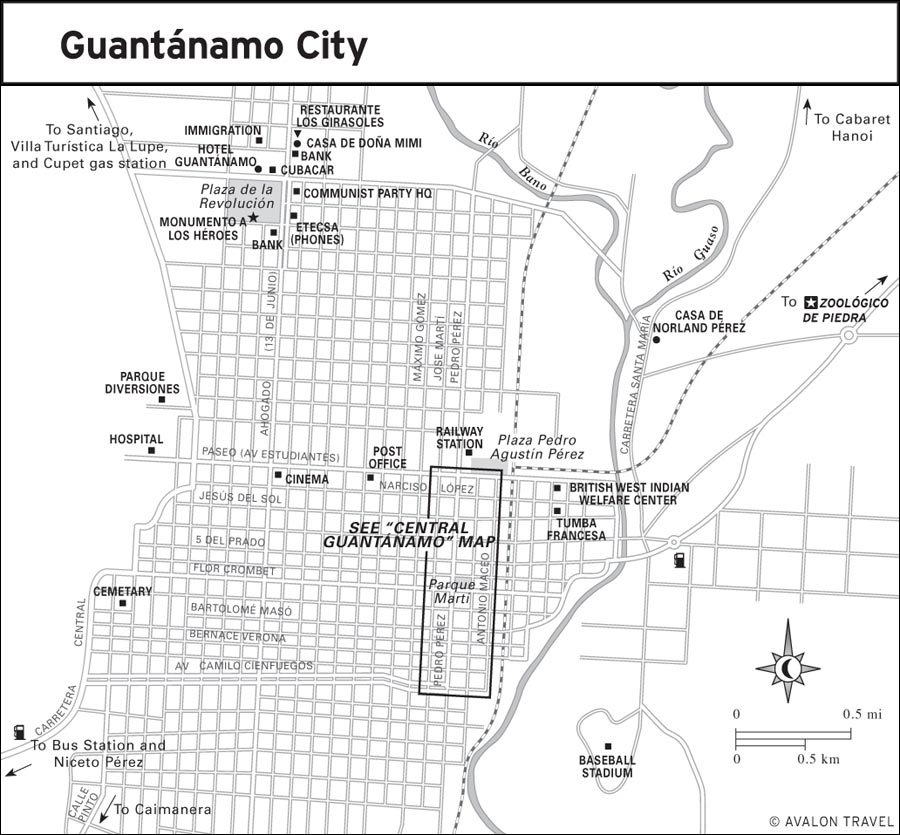
Guantánamo is laid out in a grid and approached from Santiago de Cuba by a four-lane highway that enters town from the northwest. The historic district is accessed by Paseo (Avenida Estudiantes), and further south by Avenida Camilo Cienfuegos, a wide boulevard that runs along the southern edge of downtown. North of Paseo is Reparto Caribe, where the Hotel Guantánamo overlooks Plaza de la Revolución. The center of town is Parque Martí, six blocks north of Camilo Cienfuegos and four blocks south of Paseo. Flor Crombet (El Bulevar), to the park’s south, and Aguilera, on the north side, are pedestrian precincts.
Calle 5 de Prado (one block north of Parque Martí) leads east across the Río Bano for Baracoa. A circunvalación (ring road) runs north of the city.
What little there is to see surrounds this attractive square with a beautifully restored church—Iglesia Parroquial de Santa Catalina—on the north side; note its impressive alfarje ceiling. A monument of José Martí is on the west side of the church.
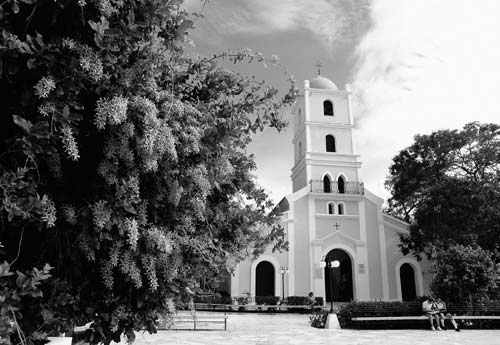
Iglesia Parroquial de Santa Catalina
Built in Parisian fashion and topped by a cupola—La Fama—bearing a herald with trumpet, the exquisite Palacio Salcido one block northwest of the square houses the Museo de Artes Decorativos (Pedro Pérez #804, esq. Prado, tel. 021/32-4407), displaying period furniture, vases, and more.
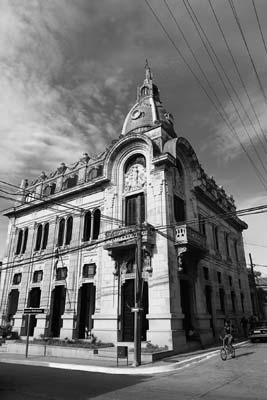
Palacio Salcido
One block west, the small but impressive Museo Provincial (Martí #804, tel. 021/32-5872, Mon.-Fri. 8pm-4:30pm, Sat. 8am-noon, CUC1) dates from 1862 and was once a prison. It has exhibits on pre-Columbian culture and natural history; cigar bands; and coins; plus a bas-relief map of the U.S. naval base and Cuban defense system. A 1940s-era Harley-Davidson in the lobby belonged to revolutionary messenger Capitán Asdrúbal.
The neoclassical Plaza del Mercado (Antonio Maceo, esq. Prado), two blocks northeast of the square, still houses an agricultural market.
The British West Indian Welfare Center (Serafín Sánchez #663, e/ Paseo y Narciso López, tel. 021/32-5297, derrick@infosol.gtm.sld.cu), an association for English-speaking descendants (locally called ingleses—Englishmen) works to keep alive the language and traditions. Some of the members were young men working on the U.S. military base when the Revolution succeeded; many continued to do so, commuting daily, until the last retired in January 2013.
This huge, barren square is enlivened by the Monumento a los Héroes, a huge concrete structure with the faces of heroes from the War of Independence. The bones of Los Mártires de Angola (Cuban military personnel who died fighting in Angola) are interred here.
Every Saturday evening, Pedro Pérez is cordoned off for a street party, while every Friday and Saturday night, local youth gather at Plaza Pedro Agustín Pérez to hear live bands perform. Fiesta a la Guantanamera, in early December, highlights traditional music and dance, as does the Festival Nacional de Changüí in mid-December.
The Casa de la Trova (Pedro Pérez, esq. Flor Crombet, no tel., daily 9am-midnight, CUC1 entrance) is a great spot to hear traditional music performed live. Watch for performances by Orquesta Revé, a local (and world-famous) exponent of son-changüí (an antecedent of son). The British West Indian Welfare Center (Serafín Sánchez #663, e/ Paseo y Narciso López, tel. 021/32-5297, derrick@infosol.gtm.sld.cu) hosts music and dance sessions featuring changüí. Tumba Francesa (Serafín Sánchez #715, e/ Jesús del Sol y Narciso López, Tues., Thurs., and Sat. 9:30am-1pm) is a great place to experience Haitian music and dance.
Beer? La Ruina (Calixto García, e/ Crombet y Gulo, tel. 021/92-9565, daily 9am-1am, free) is the place to sip suds in a colonial structure run bodega-style with wooden benches and big-screen music video. El Bulevar has several bars, such as Havana Club (Sun.-Thurs. 10am-midnight, Fri.-Sat. until 2am).
The in-spots at last visit were Club Nevada (Pedro Pérez esq. Masó, tel. 021/35-5447, Wed.-Sun. 7:30pm-2am, CUC1), an open-air nightclub with big-screen music videos that hosts karaoke on Wednesday and live music on Thursday, and Casa de la Música (Calixto García e/ Flor Crombet y Emilio Giro, tel. 021/32-7266, nightly 9pm-2am, CUC1), for sizzling salsa and jazz.
Cabaret Hanoi (tel. 021/38-2901, CUC1), four kilometers northeast of town, offers a cabaret espectáculo followed by a disco (Sat.-Sun. 10pm). The Hotel Guantánamo (Calle 13, e/ Ahogado y Oeste, tel. 021/38-1015, CUC5) also has disco nightly (8pm-1am).

One block northeast of Plaza de la Revolución and handy for services at the Hotel Guantánamo, Casa Doña Mimi (Ahogados #3106, e/ 14 y 15 Norte, Rpto. Caribe, tel. 021/38-4161, CUC20) is good value. This modern bungalow has one cool, spacious room with local TV and large hot-water bathroom, plus secure parking.
Downtown has half a dozen options. In 2013, I enjoyed a stay at Casa Señor Campos (Calixto García e/ Narciso López y Jesús del Sol, tel. 021/35-1759 or 5290-0847, mcamposcreme@yahoo.com, CU20), with a large room with double and single bed, a TV, refrigerator, and 1950s retro decor.
Worthy and similar alternatives include Casa de Elsye Castillo Osoria (Calixto García #766, e/ Prado y Jesús del Sol, tel. 021/35-4512, CUC20), with three rooms.
The stand-out option is Islazul’s Hotel Martí (Calixto García esq. Aguilera, tel. 021/32-9500, CUC31 s, CUC50 d low season, CUC35 s, CUC56 high season), which opened in 2012 on the northeast corner of Parque Martí. It has 21 pleasantly furnished air-conditioned rooms with cable TVs and clinically clean modern bathrooms. It has a restaurant.
Islazul’s Villa Turística La Lupe (tel. 021/38-2602, recepcion@lupegtm.co.cu, CUC20 s, CUC25 d year-round), four kilometers north of town on the banks of the Río Bano, draws Cubans to the noisy poolside bar on weekends. It has 50 lovely rooms with modern bathrooms in two-story units. In town, Islazul’s Hotel Guantánamo (Calle 13, e/ Ahogado y Oeste, tel. 021/38-1015, jrecephotel@hotelgtmo.cu.cu, CUC21 s, CUC39 d low season, CUC25 s, CUC40 d high season) has simpler, no-frills rooms with modern bathrooms. Services include a swimming pool and cybercafé.
Don’t raise your hopes too high!
El Bulevar on the north side of the plaza hosts Café La Primada (tel. 021/32-9182, daily 8am-3pm and 4pm-11pm), a fabulous coffee shop and chocolate store selling truffles, cakes, and Cuban chocolates and drinks sold in pesos.
For romance, head to S Restaurante Los Girasoles (Ahogados #6501, esq. 15 Norte, Rpto. Caribe, tel. 021/38-4178, daily noon-9:30pm), offering candlelit dinners, including shrimp cocktail (CUC2), in an elegant 1950s home. The night I dined here, however, it had only pork and fried chicken (CUC3). Reservations advised.
Five pesos will buy you a slice of what passes for pizza at Pizzería La Veneciana (Mon.-Sat. 10am-2:45pm and 5:30pm-10:45pm), on the east side of Parque Martí. Coppelia (Pérez, esq. Bernace Verona, Tues.-Sun. 10am-10pm) serves delicious ice cream for pesos.
You can buy produce at the mercado agropecuario (Antonio Maceo, esq. Prado, Mon.-Sat. 8am-6pm, Sun. 8am-2pm).
Infotur (Calixto García e/ Crombet y Giro, tel. 021/35-1993, Mon.-Sat. 8:30am-5pm) offers tourist info. Cubatur (Aguilera e/ Maceo y Calixto García, tel. 021/32-8342) and, next door, Havanatur (tel. 021/32-6365) can arrange excursions, including to Caimanera.
The post office (Pérez, esq. Aguilera, tel. 021/32-4668) has DHL service. Etecsa (Maceo e/ Aguilera y Prado, tel. 021/32-7878, daily 8am-7pm) has international phone and Internet service.
The Farmacia Internacional (Flor Crombet e/ Calixto García y Maceo, tel. 021/35-1129, Mon.-Fri. 9am-5pm, Sat. 9am-4pm) is relatively well-stocked. Hospital Agostinho Neto (Carretera El Salvador, Km 1, tel. 021/35-5450) is half a kilometer south of town.
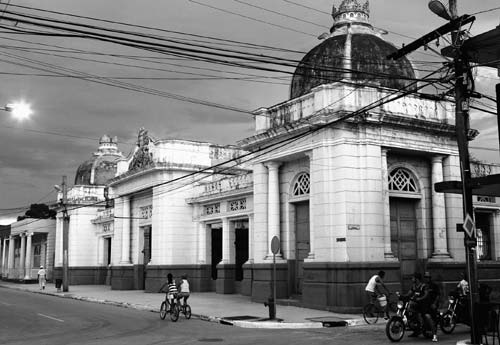
mercado agropecuario
Aeropuerto Mariana Grajales (tel. 021/32-3564), 12 kilometers east of town, is not served by international flights. Cubana (Calixto García #817, e/ Prado y Aguilera, tel. 21/32-4533) flies between Havana and Guantánamo.
The bus terminal (tel. 021/32-5588) is two kilometers south of town. Víazul (tel. 021/80121, www.viazul.com) buses for Guantánamo depart Santiago de Cuba at 7:45am (CUC6) and Baracoa at 2:15pm (CUC10). Buses depart Guantánamo for Santiago de Cuba at 5:30pm and for Baracoa at 9:35am.
The train station (tel. 021/32-5518) is on Pedro Pérez, one block east of Paseo. Train #15 departs Havana for Guantánamo every third day at 6:13pm (2CUC32). Train #16 departs Guantánamo for Havana at 8:50am.
Horse-drawn coches abound. Bus #9 runs past the Hotel Guantánamo from Paseo.
Cubataxi (tel. 021/32-3636) offers taxi service. Cubacar (tel. 021/35-5515) has car rental in the Hotel Guantánamo (Calle 13, e/ Ahogado y Oeste) and on Paseo (esq. Calixto García, tel. 021/35-5129).
You can rent scooters from Palmares Motoclub (Calixto García e/ Crombet y Giro, tel. 021/32-9565).
The U.S. naval base occupies both sides of the entrance to Guantánamo Bay, which is inhabited by endangered manatees and marine turtles (iguanas, the unofficial Gitmo mascot, roam on land).
The bay is ringed by Cuban military bases, two Cuban naval facilities (Glorieta and Boquerón) and Mirador de Malones (U.S. marines call it “Castro’s Bunker”), a command center buried deep beneath the mountain on the east side of the bay. Unbelievably, visits to the bunker have been permitted in past years, but no longer. Check with Infotur in town, or MINTUR agent Orlando Román Cuba (tel. 021/35-5991, commercial@gtm.mintur.tur.cu).
The main gate (permanently closed since 1959) is at Caimanera, 22 kilometers south of Guantánamo. This small Cuban town is surrounded by desert and salt flats; its economy is based on salt, fishing, and a Frontera Brigada military complex. Before the Revolution, many caimaneros worked on the U.S. naval base, while caimaneras worked in the strip joints and brothels that were the town’s staple industry. Remarkably, some Cuban townsfolk continued to commute for work to the base until January 2013, when the last three retired.
Caimanera is a restricted military zone, and visits by foreigners are limited to guided excursions offered by Gaviotatours and Havanatur (daily 9am-5pm, CUC14 pp with cocktail and lunch); 72 hours notice is required so that MININT can check you out. The situation is fluid and depends on the state of international relations. From the balcony of room 101 at Hotel Caimanera you can look out past Cuban watchtowers to the naval base that Castro has called “a dagger plunged in the heart of Cuban soil,” and which blazes brightly at night like a mini-Las Vegas. Bring binoculars.
Trains run to Caimanera from Guantánamo four times daily.
Far easier is to bring binoculars to Mirador El Gobernador (tel. 021/57-8908, daily 24 hours), a roadside restaurant that opened in February 2014 atop the crest of the breeze-swept ridge on the bay’s southeast side, at Glorieta, 20 kilometers east of Guantánamo city. It has a spectacular view of the entire bay (including Cuba’s Soviet T-62 battle tanks, directly below) from a lookout tower and serves simple criolla dishes plus sandwiches. It’s signed two kilometers east of the military checkpoint and the turnoff for Mirador de Malones.
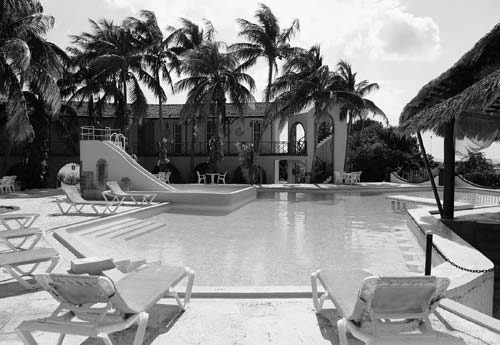
swimming pool at Hotel Caimanera, Guatánamo Bay
Islazul’s breeze-swept, hilltop Hotel Caimanera (Loma Norte, Caimanera, tel. 021/49-9414 or 5240-0762, commercial@islazulgtm.co.cu, CUC18 s, CUC22 d) has 17 modest yet perfectly adequate air-conditioned rooms plus a swimming pool and open-air restaurant. Reservations must be requested 72 hours in advance.
North of the city, sugarcane fields merge into mountains. You need your passport for a police punto de control one kilometer before the Zoológico de Piedra, beyond which a security zone is off-limits.
The “stone zoo” (no tel., daily 8am-5pm, entrance CUC1, cameras CUC1, videos CUC5), in the mountains 25 kilometers northeast of Guantánamo, features a menagerie of wild animals from around the world—lions, tapirs, hippopotamuses, elephants, and other species—hewn from huge calcareous rocks with hammer and chisel by a coffee farmer, Ángel Iñigo. Iñigo has carved more than 426 animals that he had seen only in photographs in books, representing more than 30 years of work. Over a kilometer of stone pathways lead through the thick foliage, revealing such carved scenes as a buffalo being attacked by mountain lions, two monkeys picking fleas from each other, and Stone Age figures killing a wild boar. The zoo is a work in progress.
The thatched Restaurante Mirador La Piedra (Tues.-Sun. 11am-midnight), at the zoo, has fantastic views, but don’t count on food being available.
Beyond Mirador El Gobernador, the road drops to the coast and you emerge at Playa Yateritas, a golden beach popular with residents of Guantánamo on weekends. For the next few miles, you’ll pass little coves cut into the raised coral shore.
Beyond the hamlet of Imias, the terrain turns to semi-desert, with valley bottoms filled with palms. Campismo Yacabo Abajo (tel. 021/88-0289, CUC10 pp), about five kilometers west of Imias, has modern yet basic beachfront cabins. It has a café and offers horseback rides (CUC3).
The community of Cajobabo, 45 kilometers east of Guantánamo, is hallowed ground. At Playitas, two kilometers farther east, José Martí, Máximo Gómez, and four other prominent patriots put ashore in a small rowboat on April 11, 1895, after years of exile. The tiny beachfront Museo Municipal 11 de Abril (no tel., daily 8:30am-noon and 1pm-5:30pm, CUC1) honors Martí. A replica of the boat sits outside the museum and is used each April 11, when the landing is reenacted and cultural activities are hosted. Playita can be reached by road or via a challenging three-kilometer coast trail (hire a local to guide you). Beyond the rocks at the far east end of the beach hides a tiny cove with a marble monument inset into the cliff face, laid in 1947 with a base resembling the prow of a boat at the exact spot of Martí’s landing.
The shorefront road continues east to Punta Maisí at the eastern tip of Cuba. One of the most dramatic drives in all Cuba is rarely taken by travelers but richly rewards for its incredible vistas as you ascend cactus-studded limestone plateaus—uplifted marine terraces—that comprise Reserva Ecológica Maisí-Caleta.
Immediately beyond Cajobabo, the highway turns north and climbs into the Sierra del Purial along La Farola, initiated during the Batista era (it was called the Vía Mulata) and completed since the Revolution to link Baracoa with the rest of Cuba. This highway switchbacks uphill through the valley of the Ríos Yumurí and Ojo. The road narrows with the ascent, the bends growing tighter, the views more dramatic and wide-ranging. Soon you are climbing through pine forests.
The summit (Alto de Coltillo) hosts a tiny café, beyond which the road drops through a moist valley until you emerge by the sea at Baracoa.
The unlit road is subject to landslides.
Baracoa (pop. 65,000) lies 200 kilometers east of Santiago, 120 kilometers east of Guantánamo, and is really miles from anywhere. The somnolent town nestles hard up against the ocean beneath the great hulking flat-topped mass of El Yunque. Baracoa curves around the wide Bahía de Miel (Honey Bay), lined with black-sand beaches.
Isolation breeds individuality, and Baracoa is both isolated and individual. The town looks and feels antique, with its little fortresses and streets lined with venerable wooden edifices, rickety and humbled with age.
Baracoans have a good deal of indigenous heritage, identified by their short stature, olive-brown skins, and squared-off faces.
On October 27, 1492, approaching Cuban shores for the first time, Christopher Columbus saw “a high, square-shaped mountain, which looked like an island.” For centuries, it was widely accepted that the mountain he saw was El Yunque. It is now thought that Columbus was actually describing a similar flat-topped mountain near Gibara, many miles to the west (Baracoans, however, are staunchly partisan on the subject).
In 1510, Don Diego Velázquez de Cuellar arrived fresh from Spain with 300 men and founded La Villa de Nuestra Señora de la Asunción, the first of the original seven cities founded by Velázquez. As such, it is the oldest colonial city in the Americas.
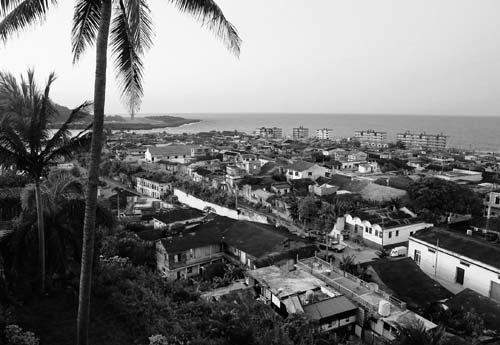
Baracoa at dawn
Baracoa’s remote geographical circumstance did little to favor the settlement. After five years, Santiago de Cuba, with its vastly superior harbor, was proclaimed the new capital. Baracoa languished in limbo for the next four centuries, without road or rail link to the rest of Cuba until La Farola was completed in the early 1960s.
La Farola enters town from the east as Calle José Martí. The town is only a few blocks wide, with narrow roads running parallel to the shore. The Malecón runs along the seafront, two blocks north of Martí. From Holguín, the town is accessed via Avenida Primero de Abril, which curls around the western harbor.
Dominating the town is El Castillo, a fortress—Castillo Seboruco—atop the rocky marine terrace that looms above Baracoa, offering a bird’s-eye view. It was built during the War of Jenkins’ Ear (1739-1741) between Spain and Britain, when the two nations’ navies battled it out over the issue of trading rights in the New World. It has metamorphosed as the Hotel El Castillo and is accessed by a steep staircase at the southern end of Frank País.
Tiny Fuerte Matachín, at the east end of Martí and the Malecón, dates to 1802 and guards the eastern entrance to town. A bronze bust of General Antonio Maceo stands outside the fortress, with its thick walls topped with cannons. The storehouse houses the Museo Matachín (tel. 021/64-2122, daily 8am-noon and 2pm-6pm, CUC1 entrance, CUC1 camera), tracing the history of the region since pre-Columbian days. It also displays shells of the painted snail. The round tower—Torreón de Toa—immediately south of the fort served as a Spanish customs checkpoint.
The Fortaleza de la Punta, at the west end of Martí, was built in 1803 to guard the harbor entrance.
This triangular plaza (Antonio Maceo, e/ Frank País y Ciro Frias) is the town hub and is pinned by a bust of Hatuey, the native chief who led resistance to Spanish rule. It is dominated by the recently restored Catedral Nuestra Señora de la Asunción (daily 7am-11am and 4pm-7pm), dating from 1805 on the site of an earlier church destroyed by pirates in 1652. The church is famous for the “Cruz de la Parra,” a dark, well-worn, meter-tall cross (supposedly the oldest European relic in the Americas). Baracoans believe that Columbus left the cross upright amid stones at the harbor entrance in 1492. Carbon-dating analysis confirms that it is indeed about 500 years old, although scientific study by experts determined that the cross was made of Coccoloba diversifolia, a native New World hardwood that grows abundantly around Baracoa. Perhaps Columbus whittled the cross himself in Cuba!
Avenida Maceo runs west from the plaza as a lovely pedestrian boulevard studded with sculptures. Casa de Cacao (tel. 021/64-2125, Mon.-Fri. 7am-11pm and Sat.-Sun. until 2am) produces hand-made chocolates and has a gallery explaining the production of cacao and chocolate. Live music is offered in the patio.
The highlight of Baracoa is this archaeological museum (no tel., Mon.-Fri. 8am-5pm, Sat.-Sun. 8am-noon, CUC2), inside a cave on the southern side of town. Aboriginal artifacts, carvings, jewelry, and skeletons are displayed within floodlit glass cases ensconced within crevices between the dripstone formations. A funerary cave has skeletons in situ; access is via makeshift wooden scaffolding: You clamber at your own risk! Follow Calle Moncada uphill to a tiny traffic circle; the museum is signed from here.
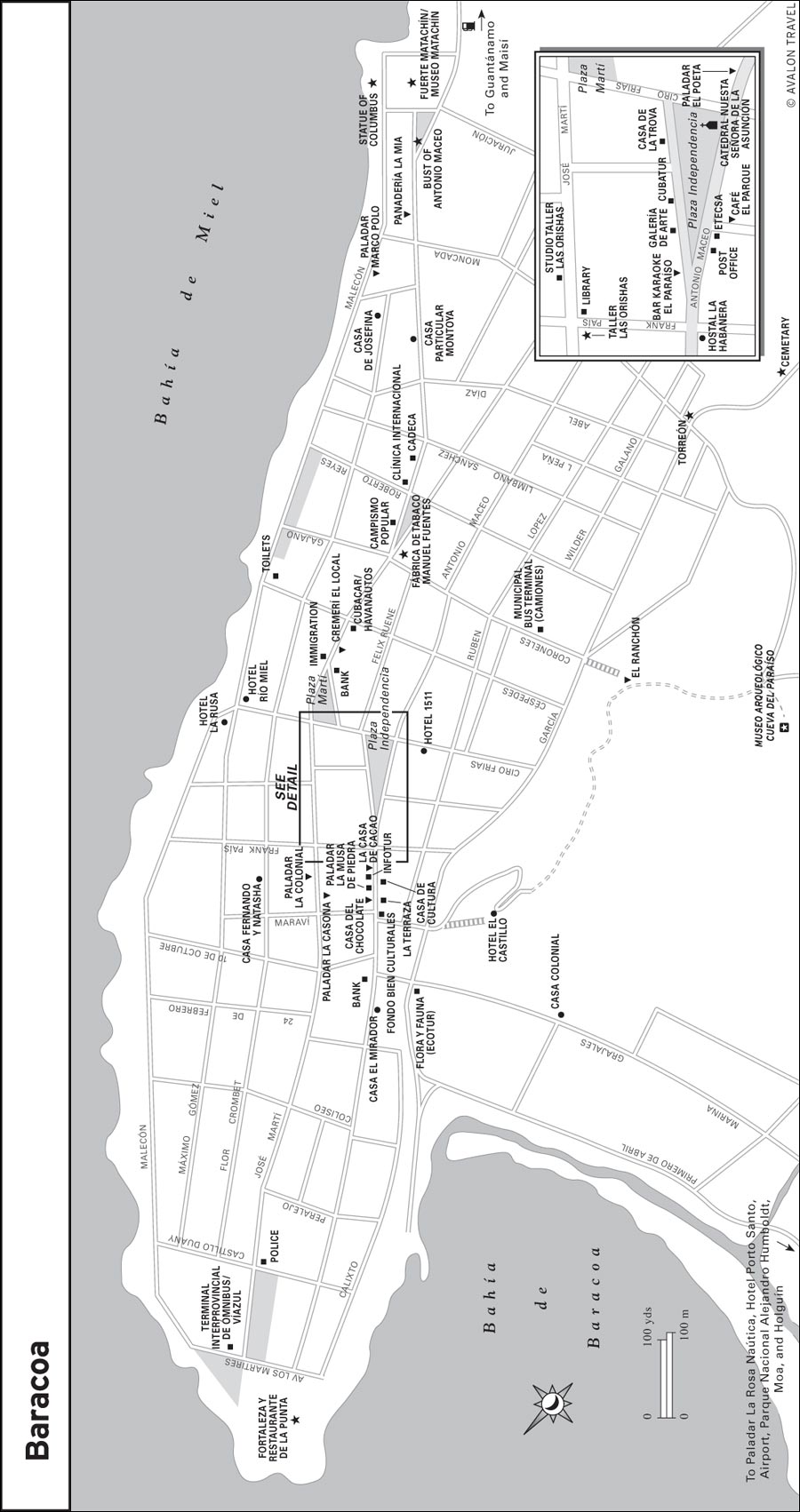
Other caves with dripstone formations and Taíno petroglyphs (local archaeologists purport one of them represents Columbus’s three caravels) are protected in Parque Natural Majayara, reached by walking along the shore east of town.
This small zoo (tel. 021/64-3409, Tues.-Sun. 8am-4pm, 20 centavos), seven kilometers east of Baracoa, displays monkeys, a hippo, a lion, birds, crocodiles, rodent-like jutías, and a near-extinct relative, the almique, endemic to eastern Cuba.
The Semana de la Cultura, a week-long cultural festival, kicks off on April 1 to celebrate Antonio Maceo’s landing at nearby Duaba in 1895.
Every Saturday night, a street party—fiesta callejera—is set up on Calle Maceo, which is cordoned off and lit with Christmas lights, while the boom-box music reverberates until well past midnight and only the dead can sleep.
The Casa de la Trova (Maceo #149, e/ Ciro Frías y Pelayo Cuervo, no tel., daily 9pm-2am, 10 pesos) is one of the liveliest and most intimate venues in Cuba for savoring traditional music, such as local adaptations of Cuban son known as nengón and kiriba. Casa de la Cultura (Maceo, e/ Frank País y Maraví, tel. 021/64-2364) and El Patio BFC (Mon.-Sat. 5pm-12:30am and Sun. 8:30pm-12:30am), 50 meters west, are similar.
For boy-meets-girl, it all happens at the open-air Café El Parque (tel. 021/64-1206, 24 hours) on the south side of Plaza Independencia. Local youth shake their booty to reggaeton at the hilltop El Ranchón (no tel., daily 9pm-2am, CUC1), 800 meters east of the Hotel El Castillo (you can also ascend the dark staircase at the south end of Coroneles Gajano).
The rooftop La Terraza (Maceo, e/ Maraví y Frank País) has a middling cabaret espectáculo (Tues.-Sun. at 11pm, CUC1).
Estadio Manuel Fuentes Borges, east of town, hosts baseball games October-May.
Galería Eliseo Osoris (Félix Ruenes #25, Mon.-Fri. 9am-noon and 4pm-9pm, Sat.-Sun. 4pm-10pm), on the north side of Plaza Independencia, sells paintings and sculptures. Also try the Bien Fondo Culturales (Maceo #120); the Taller la Musa (Calle Maceo #124, e/ Maraví y Frank País), where noted artists Roel Caboverde and Orlando Piedra sell original paintings; and Studio Taller Las Orishas (Martí #131, e/ Frank País y Pelayo Cuervo, www.luiseliades.com).
There are scores of private rooms for rent. All are air-conditioned and most serve meals. Here are a few of my faves.
For an independent apartment, try Casa Fernando y Natasha (Flor Crombet #115, e/ Frank País y Maraví, tel. 021/64-3820, CUC20-25), where the friendly owners were tremendously attentive when I stayed here. They offer two spacious upstairs rooms with modern bathrooms and heaps of light. Meals are served on a rooftop terrace. I also enjoyed my stay at Casa de Josefina (Flor Crombet #269, tel. 021/64-1928, CUC15-20), where the pleasant hosts offer two rooms, each with fan, private bathroom, and terrace.
Casa Particular El Mirador (Maceo #86, e/ 24 de Febrero y 10 de Octubre, tel. 021/64-2647, ilianacu09@gmail.com, CUC15-20) is one of the best room rentals. Hostess Iliana Sotorongo Rodríguez’s attractive colonial home has two spacious upstairs rooms with fans and lofty ceilings that open to a balcony with rockers and views.
My preferred option is S Casa Colonial (Marian Grajales #35, tel. 021/64-2267, CUC15-20), a lovely old home with 1950s retro decor run by attentive owner Isabel Castro. The home opens directly to a rear garden patio that gets the sun. It has secure parking.
All hotels are operated by Gaviota (reservas@gavbcoa.co.cu) and have air-conditioned rooms with satellite TV.
Thumbs up for S Hostal La Habanera (Maceo #126, esq. Frank País, tel. 021/64-5273, reservas@gavbcoa.co.cu, CUC30 s, CUC35 d low season, CUC35 s, CUC40 d high season), a splendid restoration of a colonial-era hotel. Its 10 rooms around a central atrium patio have high ceilings, pleasant rattan furniture, and modern bathrooms. There’s a small bar and restaurant.
The Hotel Río Miel offers a pleasing boutique elegance in its 12 rooms with mahogany furnishings and snazzy modern bathrooms. It has a hip bar and an air-conditioned shorefront restaurant. The exquisite yet tiny Hostal 1511 (CUC30 s, CUC35 d low season, CUC35 s, CUC46 d high season) has tasteful modern furnishings and modern bathrooms. There’s no restaurant, but you’re a stone’s throw from several paladares.
For a room with a view opt for Hotel El Castillo (Calle Calixto García, Loma del Paraíso, tel. 021/64-5106, CUC42 s, CUC56 d low season, CUC44 s, CUC60 d high season), built atop the foundations of El Castillo. It has 62 rooms (those in a newer block are the best) furnished colonial style, with balconies with El Yunque views. The swimming pool is a major reason to stay here.
A lesser yet identically priced alternative is Hotel Porto Santo (Carretera del Aeropuerto, tel. 021/64-5106, CUC42 s, CUC56 d low season, CUC44 s, CUC60 d high season), on the west side of the bay. Its 36 rooms and 24 cabinas surround an amoeba-shaped pool, and it has tennis.
A last resort is the 12-room Hotel La Rusa (Máximo Gómez #161, tel. 021/64-3011, larusa@enet.cu, CUC20 s, CUC25 d low season, CUC25 s, CUC30 d high season), facing the Malecón.
The best of a dozen paladares is S El Poeta (Maceo #159, e/ Ciro Frias y Céspedes, tel. 021/64-3017, elpoetapabloleyva@yahoo.es, daily 9am-10pm). Its rustic ambience is a perfect foil for owner Pablo Leyva to burst into improvised verse in typical Cuban country fashion. The kitchen delivers delicious Baracoan specialties, including soup served in a gourd, tamal stuffed with crab, and spicy shrimp with coconut-flavored rice.
You might find me at La Casona (Martí 114 esq. Maravi, tel. 021/64-1122, daily 11am-11pm), an airy colonial home with heaps of cozy colonial charm and great service. The chef special is seafood in coconut milk (CUC12), but I enjoyed both a lobster (CUC12) and lamb in wine (CUC8). Bargain prices include soup and salad.
La Colonial (Martí #123, e/ Maraví y Frank País, tel. 021/64-5391, daily 10am-11pm) serves swordfish, shark and dorado in huge portions (most dishes CUC7).
I also enjoyed La Rosa Náutica (1ra de Abril #85 altos, tel. 021/64-5764 or 5814-4654, daily noon-midnight), with rooftop dining and a simple elegance. The menu features gazpacho (CUC1), chicken soup (CUC1), lobster (CUC10), and the house dish of marinated rabbit (CUC7).
For seafront dining, head to Paladar Marco Polo (Malecón #82 e/ Moncada y Colores, tel. 021/64-2497 or 5355-3623, daily 7am-11pm), a simple affair serving lobster (CUC12) and criolla staples.
Although it has its off nights, Restaurante La Punta (tel. 021/64-1480, daily 10am-10pm), in Fortaleza de la Punta, can’t be beat for its setting and colonial ambience. The limited criolla menu includes a fish, crab, and shrimp special (CUC9).
You can buy a chocolate drink, natilla (a kind of chocolate mousse), and chocolate bars for pesos at the Casa del Chocolate (Antonio Maceo #121, esq. Maraví, tel. 021/64-1553, daily 7:30am-10:30pm), and Casa de Cacao (tel. 021/64-2125, Mon.-Fri. 7am-11pm and Sat.-Sun. until 2am), where artisanal chocolates are made on-site.
Infotur (Maceo #129-A, e/ Maravi y Frank País, tel. 021/64-1781, Mon.-Sat. 8:30am-5pm) has a tourist information bureau with Internet service (CUC6 per hour).
The post office (daily 8am-8pm) is on Plaza Independencia. Next door, Etecsa (Maceo #134, tel. 021/64-2543, Mon., Wed., and Fri. 8:30am-4pm, Tues. and Thurs. 12:30pm-7pm, and Sat. 8:30am-11:30am) has international telephone and Internet service.
Bandec has branches at Maceo (esq. Marina Grajales) and on Plaza Martí.
Hospital General Docente (tel. 021/43014, 021/42568 for emergencies) is two kilometers east of town. The Clínica Internacional (Martí, esq. Reyes, tel. 021/64-1038, daily 8am-8pm) has pharmacy.
The police station is on Martí (e/ Duany y Coliseo).
Aeropuerto Gustavo Rizo (tel. 021/64-2216) is on the west side of the bay. AeroGaviota flies between Havana and Baracoa on Wednesday and Saturday (CUC126); AeroCaribbean flies Thursday and Sunday (CUC164). Tickets can be purchased through Gaviotatours.
Buses arrive and depart the Terminal Interprovincial (Los Mártires, esq. Martí, tel. 021/64-3880). Víazul buses (tel. 021/64-3093, www.viazul.com) connect Baracoa twice-daily with Guantánamo, Santiago de Cuba, and farther afield.
Gaviotatours has a daily transfer between Baracoa and Holguín (8am, CUC26), and Transtur has a transfer to Santiago de Cuba Monday, Wednesday, and Friday at noon (CUC15), returning to Baracoa Tuesday, Thursday, and Saturday at 8am.
You can rent cars from Cubacar (Martí #202, tel. 021/64-2555) and Vía (tel. 021/64-5135) at the airport and at Café El Parque on Plaza Independencia.
For a taxi, call Cubataxi (tel. 021/64-3737), or hail one of the old Willys Jeep private taxis, which are a staple of local transport.
Cubatur (Martí #181, tel. 021/64-5306, cubatourbaracoa@enet.cu), Havanatur (Martí #202, tel. 021/64-5358), and Gaviotatours (Calle Calixto García, Loma del Paraíso, tel. 021/64-4115), in the Hotel La Habanera, offer excursions. Gaviotatours also has an office in Cafetería El Parque (tel. 021/64-5164). EcoTur (Calixto García, esq. Marina Grajales, tel. 021/64-3665, ecoturbc@enet.cu, Mon.-Sat. 8am-6pm) handles excursions into the nearby national parks.
There are gas stations beside Fuerte Matachín and one kilometer east of town.
West of Baracoa, the 208,305-hectare Cuchillas de Toa Biosphere Reserve encompasses most of the Alturas de Sagua-Baracoa, Cuchillas de Toa, and Cuchillas de Moa mountain ranges, and rises from sea level to 1,139 meters in elevation. The reserve has diverse climate types and ecosystems and protects the richest flora and fauna in Cuba, including more endemic species than anywhere else on the island, not least the Polymita pictas (a colorful snail species).
Much of the area is forested in Cuban pine, a perfect habitat for the ivory-billed woodpecker and its cousin, the endemic and endangered royal woodpecker. The ivory-billed woodpecker was once common throughout the American South, but they have not been seen in the United States since the 1940s. The bird was considered extinct until the mid-1980s, when it was identified in these mountains. The sightings resulted in the Cuban government’s establishing a 220-square-kilometer protection area. No sightings have since been made.
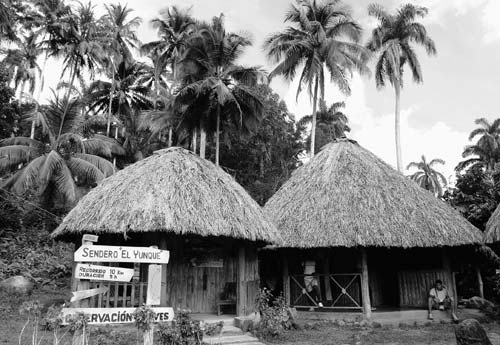
trailhead to El Yunque, Parque Natural El Yunque
The reserve, under the aegis of CITMA (Ciencias Tecnología de Ambiente, Martí #133, esq. Frank País, tel. 021/64-3300, conservacion@toa.gtm.sld.cu), is divided into several national parks. Visits are coordinated through EcoTur (Calixto García, esq. Marina Grajales, tel. 021/64-3665, ecoturbc@enet.cu), which has an office at Campismo El Yunque.
At the mouth of the Río Duaba, five kilometers west of Baracoa, is Playa Duaba, a black-sand beach where General Antonio Maceo and 22 compatriots landed in April 1895 to fight the War of Independence. Immediately beyond is the site where he fought his first battle. He is honored by a roadside monument with bust and cannon.
You can turn inland here and follow a dirt road one kilometer to Finca Duaba (no tel., daily 8am-4pm), a fruit farm with a restaurant serving criolla meals. Guided tours (CUC1) include a demonstration of cacao processing.
The park enfolds El Yunque (“the anvil”), the spectacular table-top mountain (575 meters) that dominates the landscape west of Baracoa. This sheer-sided giant—the remains of a mighty plateau that once extended across the entire area—was hallowed by the Taíno. Mists flow down from the summit in the dawn hours, and it glows like hot coals at dusk, when the setting sun pours over the red rocky walls like molten lava. Waterfalls pour from its summit.
You can hike to the summit daily 8am-3pm (four hours round-trip, CUC13 from Campismo El Yunque, CUC15-182 from Baracoa; a guide, water, and lunch are compulsory). From the coast highway, take the signed turnoff for Finca Duaba, then keep left at the Y fork (the campismo is to the left; Finca Duaba is to the right). Sendero El Jutiero from the campismo leads to cascades and pools good for swimming (CUC8, 40 minutes).
This park, immediately west of Parque Natural Duaba, extends into the interior mountains. The seven-kilometer-long Sendero Juncal Rencontra trail transcends the mountains, leading from the Río Duaba to the Río Toa; guided hikes (CUC22 from Baracoa) end with a boat or jeep return.
This 70,835-hectare park extends into Holguín Province. A guide is compulsory. There’s a two-meter-tall statue of the German explorer roadside near the visitor center (daily 8am-7pm), with 3-D map of the park, on the east side of Recreo, five kilometers west of the Río Nibujón. The Sendero Balcón de Iberia leads inland to waterfalls and natural swimming pools (five hours, last departure at 11am, CUC10, or CUC22 with transport from Baracoa). The shorter Sendero El Recreo (CUC10) hugs the shore of Parque Natural Bahía de Taco, incorporated within Parque Nacional Alejandro de Humboldt and protecting 2,263 hectares of marine ecosystems, including mangroves, an offshore cay, and white-sand beaches shelving to a coral reef. Manatees are often seen. The Sendero Bahía de Taco includes a boat excursion (CUC5).
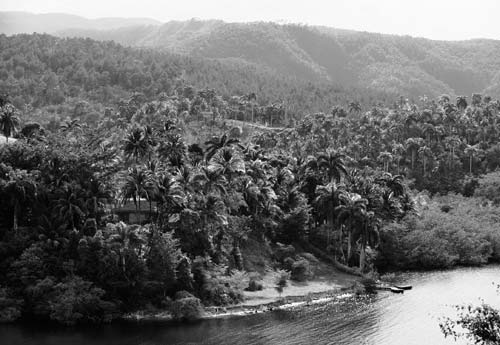
Parque Nacional Alejandro de Humboldt
Campismo El Yunque (tel. 021/64-5262), midway between Finca Duaba and the summit of El Yunque, has 16 basic huts, each sleeping up to six people. Even more rustic, Finca La Esperanza (CUC20 pp, including meals and boat tour), at the mouth of the Río Toa, has four basic rooms, each with four beds and fans.
Gaviota’s S Villa Maguana (Carretera de Moa, Km 20, tel. 021/64-5106, CUC57 s, CUC73 d low season, CUC66 s, CUC83 d high season, including meals), 28 kilometers west of Baracoa, nestles in its own cove with a white-sand beach and turquoise waters. It has 16 lovely rooms with modern bathrooms in two-story fourplex wooden structures.
The coast road east from Baracoa follows a winding course inland via the hamlet of Jamal, touching the coast again 20 kilometers east of Baracoa at Playa Baragua—a ruler-straight silver-sand beach with a fabulous view towards El Yunque. Break out the camera!
About 15 kilometers east of Baracoa, divert off the main road to the hamlet of El Güirito, where descendants of Taíno people keep alive the kiriba and nengón music and dance traditions. The Kiriba-Nengón cultural group dresses in traditional country attire (long flowery skirts and frilled lace blouses) and performs for visitors.
Beyond Baragua, the road eventually passes through a cleft in the vertical cliffs spanned by a natural arch called Túnel de los Alemanes (Germans’ Tunnel). Beyond, you emerge at Boca de Yumurí, where the Río Yumurí cuts through a deep canyon to meet the Atlantic breakers. You can rent pedal boats at Café Yumurí (daily 10am-6pm), and locals will accost you as you step from your car to row you upriver (CUC2 round-trip).
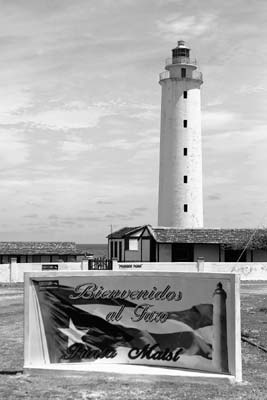
Punta Maisí lighthouse
Immediately east of the Río Yumurí, the road begins a daunting first-gear switchback ascent and winds its way into the mountains and the town of La Máquina, the center of a coffee growing region on the cooler eastern slope of the Meseta de Maisí, 22 kilometers beyond the rivermouth.
La Máquina looks down over a vast plain studded with cacti. Far below, a faro built in 1862 at Punta Maisí pins the easternmost tip of Cuba, where day breaks 40 minutes before it occurs in Havana. A paved road track descends from La Máquina past Laguna de Limones (a lake accessed by trails) to the lighthouse, 14 kilometers away. You have reached land’s end, 1,280 kilometers from Havana.